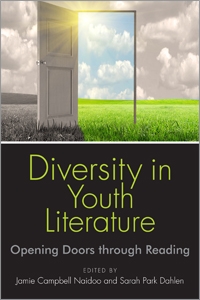Primary tabs
You don't need to be an ALA Member to purchase from the ALA Store, but you'll be asked to create an online account/profile during the checkout to proceed. This Web Account is for both Members and non-Members.
If you are Tax-Exempt, please verify that your account is currently set up as exempt before placing your order, as our new fulfillment center will need current documentation. Learn how to verify here.
- Description
- Table of Contents
- About the authors
- Reviews
Surveying the landscape of children's and YA literature, this contributed volume shows how books have grown to include the wide range of our increasingly diverse society. Identifying both exemplary and problematic titles, the contributors
- Provide context by sketching out the historical trajectory of diversity in youth lit
- Organize titles into sections that range from familiar themes (African American, Asian, Latino) to the lesser known (such as literature dealing with incarceration, transnational adoption, and homelessness)
- Offer guidelines for evaluating and selecting the best in diversity literature
- Suggest youth-tested programs and strategies to promote multicultural books in the library and classroom
This thoughtful and timely book helps meet the informational, recreational, and cultural needs of today's youth and those who serve them.
Acknowledgments
Editors’ Introduction Open Books, Open Doors: Cultural Diversity On and Off the Page
Part 1 Overview of Diversity in Children’s and Young Adult Literature
Chapter 1 Voices of Experience: Promoting Acceptance of Other Cultures
Carol Doll and Kasey Garrison
Chapter 2 Opening Doors to Understanding: Developing Cultural Competence through Youth Literature
Eliza Dresang
Part 2 Exploring Marginalized, Oppressed, and Under/Misrepresented Communities in Youth Literature
Chapter 3 African American Children’s Literature: Liminal Terrains and Strategies for Selfhood
Ebony Elizabeth Thomas
Chapter 4 Promising Portals and Safe Passages: A Review of Pre-K–12 Latino- and Latina-Themed Literature
Ruth Quiroa
- Sliding Door 1 The Politics of Publishing Latino Children’s Books, Oralia Garza de Cortés and Jennifer Battle
- Sliding Door 2 Re-Storying Nuestro Barrio: Mentoring Children’s Picture Book Writing with Latino/Latina Children’s Literature, Jesse Gainer, Angie Zapata, and Nancy Valdez-Gainer
Chapter 5 Beyond Sari, Hindu Monkey God, and Divali: A Critical Analysis of South Asian Cultures and Childhoods Represented in Picture Books
Eun Hye Son and Yoo Kyung Sung
Chapter 6 “That’s So Chamorro”: Representations of Culture in Chamorro Realistic Fiction
Monique Storie
Chapter 7 Growing Mixed/Up: Multiracial Identity in Children’s and Young Adult Literature
Amina Chaudhri
Chapter 8 The Door Has Never Opened for Us: The Roma in Recent Children’s Fiction for Grades 4–6
Brian W. Sturm and Meghan Gaherty
Chapter 9 Building a Core Collection: Muslim Experiences in English Language Children’s Books, September 2001–September 2011
Anna Nielsen
Chapter 10 Holding Out Hope: Homelessness in Children’s and Young Adult Literature
Kim Becnel
- Sliding Door 3 Bibliotherapy and Characters with Cognitive Disabilities, Karen Gavigan
- Sliding Door 4 Korean Folktale Video Project for Multicultural Families and Foreigners in the Republic of Korea, Wooseob Jeong and Sook-Hyeun Lee
Chapter 11 How to Evaluate Children’s and Young Adult Books about Transracial and Transnational Asian Adoption
Sarah Park Dahlen
Chapter 12 Representation in Queer Children’s Books: Who’s In and Who’s Out
Jamie Campbell Naidoo
Chapter 13 Rediscovering Filipino Children’s Literature: Lola Basyang and Me
Danilo M. Baylen
Further Reading
About the Editors and Contributors
Index
Jamie Campbell Naidoo
Jamie Campbell Naidoo, PhD, is an endowed associate professor at the University of Alabama School of Library and Information Studies. A former elementary school librarian and children's librarian, he teaches and researches in the areas of library services and programs to diverse populations. Dr. Naidoo has published numerous works on Latino children's literature and librarianship, including the book Celebrating Cuentos: Promoting Latino Children's Literature and Literacy in Classrooms and Libraries (Libraries Unlimited, 2010). He is active in REFORMA (The National Association to Promote Library and Information Services to Latinos and the Spanish-Speaking) and ALSC (Association for Library Service to Children).
Sarah Park Dahlen
Sarah Park Dahlen is an assistant professor of library and information science at St.Catherine University in St. Paul, Minnesota. She teaches courses in library materials for children and young adults, library services for youth, storytelling, and introduction to library and information science. Her research interests include representations of the Korean diaspora in children's literature, children's librarianship, transracial adoption,social justice, and Korean diasporic history. She has served on several children's book award committees and is currently serving as the chair of the Asian/Pacific American Librarians Association's Literature Awards Committee for Children's Literature.
"This compact book offers a wealth of collection-development guidance regarding multicultural literature for children and teens, and notably includes the LGBTQ perspective as well. Recommended for the neophyte youth services collection-development librarian or for those seeking to update a youth collection to reflect patron diversity, this book is a handy companion that incorporates thoughtful reflections on the historical context of diversity within youth literature (or the lack thereof) into 13 easy-to-digest chapters. Other features include literature lists, an index, and a 'Further Reading' reference section, which presents additional articles, books, and online resources to expand and ensure high-quality purchases from the canon of children’s literature written for and by those reflecting diverse backgrounds."
–– Booklist
"It is exemplary and should serve as an inspiration for other contexts."
–– Bookbird



